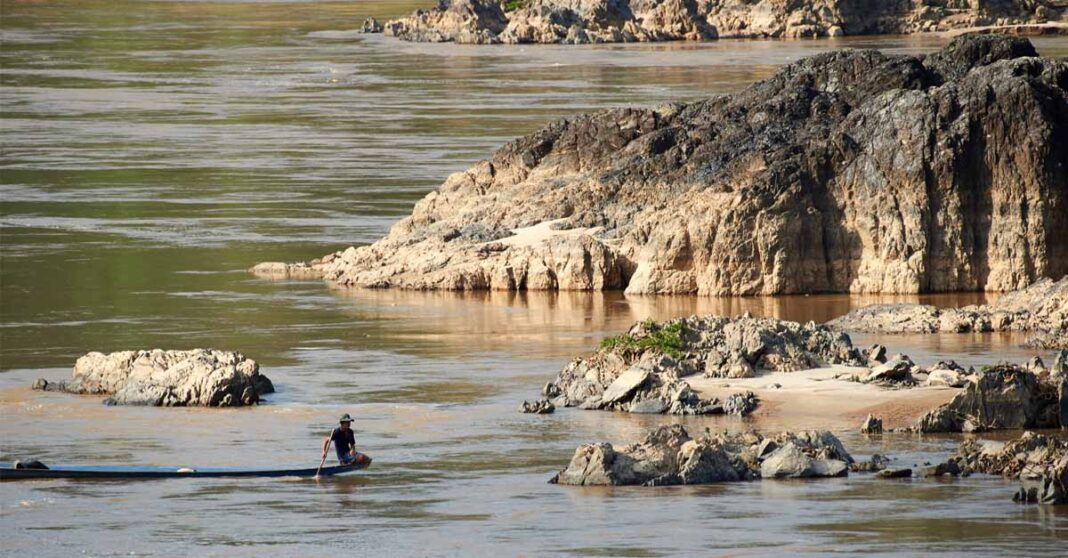Two hydropower projects along Southeast Asia’s most important river have had measurable, but moderate, impact on water flow, sediment and fisheries, according to preliminary findings of a report by the Mekong River Commission (MRC) released last week.
With roughly one year of monitoring data, it’s still very early in the process to draw any conclusions, as a multinational team of investigators for the MRC-Joint Environmental Monitoring (JEM) program test protocols that measure five key indicators of the Mekong’s health: hydrology, sediment, water quality, aquatic ecology, and fisheries.
By testing this at two relatively new hydropower projects – the Don Sahong and Xayabury– the MRC aims to create monitoring methods and standards that all hydropower operators on the Mekong mainstream will follow in the future.
Among its most significant findings, the monitoring teams observed that the overall river flow patterns did not change. The river’s ecological health was “good” at upstream dam sites, “moderate” within the dam impoundment sites, and “moderate” downstream of both dams. Water quality remains “within human health thresholds.”
Within dam impoundments, there is no evidence of stratification – which can affect both water quality and fisheries. Once water passes through the dams, “there is little evidence of change in downstream water quality.”
The monitors also detected some daily water level fluctuation, downstream of the Xayabury project in Lao PDR – which could affect the ecosystem. However, this didn’t occur downstream of the Don Sahong dam.
The JEM team also observed the pattern that began in 2018: a decreasing of sediment concentration and sediment loads, which bring nourishing nutrients and stabilize riverbanks. Yet this reduction “may be due to trapping at both tributary and mainstream” hydropower projects.
Finally, the team observed some changes in fish diversity upstream of Xayabury, with some stability from 2017 to 2019 and a reduction in 2020. Downstream of the reservoir, diversity remains high. On the other hand, fish catch seems stable, with high value reported in 2017, lower in 2018–2019 and higher again in 2020.
Around Don Sahong, though, monitors observed puzzling findings: over the years, a fish catch decline in northern Cambodia, but an increase immediately downstream of the dam.
That said, these findings were drawn from one monitoring cycle; the JEM team suggests monitoring over the next two-three years, to draw a “strong conclusion” about the impact of hydropower development and other human pressures.
“We must understand the scope of our challenges, and identify the most effective methodology to measure it,” says the MRC Secretariat CEO, Dr Anoulak Kittikhoun. “While this report sheds some light on the impact of hydropower, it’s too early to attribute every impact to the dams. Climate change and other developments are also factors.”
Overall, this JEM report is part of a broader effort by the MRC – which represents Member Countries Cambodia, Lao PDR, Thailand and Viet Nam – to strike a balance: between the economic and societal benefits of hydropower, and the industry’s impact on not only the environment, but on the millions of fishing and farming families who rely on the Mekong for their livelihood.
For this JEM pilot project, a diverse team of monitors tested their protocols for about one year, after the pandemic caused significant delays. Their report will likely become a foundation for both future policies and monitoring activities.
As the report itself states, their findings can shape future hydropower projects “siting and design, prediction of changes relating to the project operation, and development, application and evaluation of mitigation and management measures.” Moreover, it can provide a “basis for constructive discussions” between riverine communities and MRC members.
Among its dozen plus recommendations to the MRC, Member Countries and hydropower operators, the report recommends that to mitigate impact on hydrology, sediment and fisheries, they should jointly introduce “targets or limits on the rate of water level change” in the Mekong mainstream; implement a central communication notification system; jointly operate low level gates for sediment transport; and in the Don Sahong’s case, deepen the entrance of fish passages and improve their channels.
As for future projects, the report calls for “systematic water monitoring during all phases of hydropower construction and operation, so that appropriate action can be taken if poor water quality conditions emerge.”
The MRC is also discussing how to integrate JEM monitoring into the new Core River Monitoring Network, to ensure long-term monitoring, reporting and adaptive management that is important to safeguard the Mekong River.



